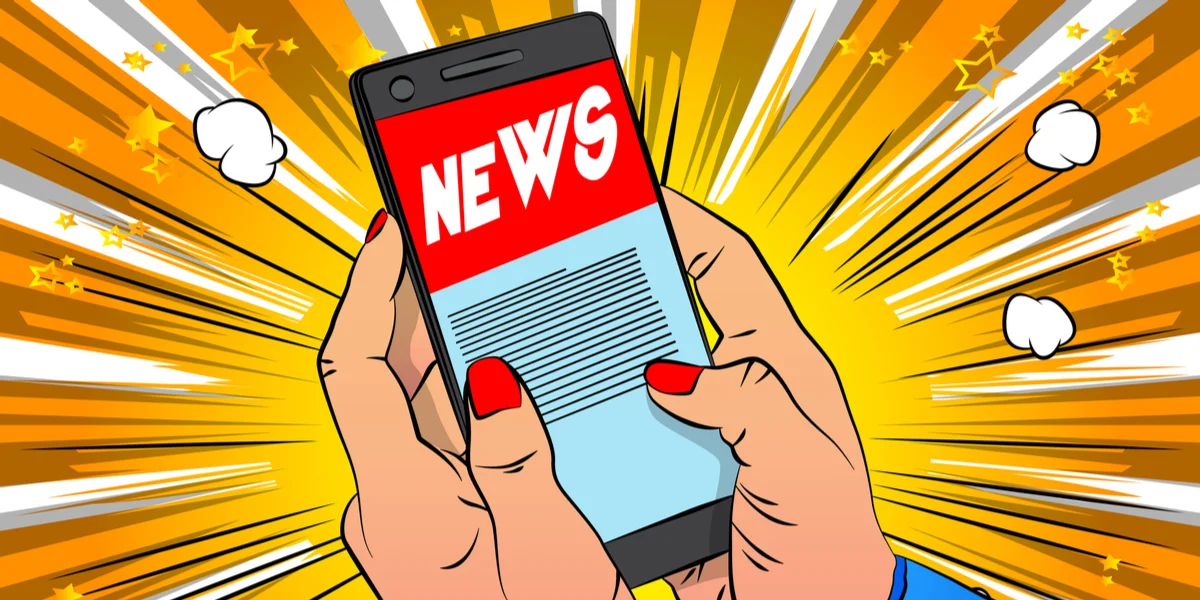
In today’s hyperconnected world, news breaks faster than it can be broadcast. By the time a reporter reaches the scene, hundreds of tweets, videos, and amateur live streams are already viral. Traditional media can no longer afford to rely solely on TV bulletins or print editions to reach their audiences. The battleground has shifted online, where speed, visibility, and digital trust decide who leads the news cycle.
To stay relevant, trusted, and competitive, modern news channels must embrace digital marketing—not as a side function, but as their primary communication lifeline.
Remember when people waited patiently for the 9 PM bulletin? When news anchors were the gatekeepers of truth and “breaking news” meant something rare and urgent? Fast forward to today: every minute, something is “breaking,” and audiences no longer wait—they scroll, they swipe, they share.
This massive shift in behavior has forced news channels to confront a reality they once resisted: the age of digital-first journalism is here, and digital marketing isn’t just useful—it’s critical to survival.
The modern news landscape is facing a paradox. On one hand, there’s more access to information than ever. On the other, audiences are increasingly distracted, skeptical, and overwhelmed. Amid the noise, how can a news channel cut through, stay credible, and engage meaningfully?
The answer lies in a powerful yet often underestimated tool: digital marketing. It’s not about selling products—it’s about building trust, reaching audiences where they are, and delivering content in the formats they prefer. From social media storytelling to SEO headlines, this is where journalism meets strategy.
TikTok has become a breaking news source. YouTube Shorts are replacing 30-minute news segments. Twitter (X) trends decide the editorial focus of the evening broadcast. We are no longer living in an era where digital is the future—it is the present.
News channels that fail to master digital marketing risk fading into irrelevance. Those that embrace it are not just surviving—they’re thriving, expanding their reach, and building communities in ways never before possible.
Just as Netflix disrupted cable, digital marketing is revolutionizing the way news is consumed, shared, and monetized. The platforms have changed. The audience behavior has evolved. The competition is no longer just other channels—it’s influencers, vloggers, and citizen journalists with faster upload speeds.
The question isn’t whether news channels should invest in digital marketing. The real question is: how fast can they adapt before they’re left behind?
Table of Contents
Sr. Headings
1) Introduction
2) The Digital Shift in News Consumption
3) Core Digital Marketing Strategies for News Channels
-SEO
-Social Media Marketing
-Email Marketing
-Influencer Collaborations
-Video Content
4) Case Studies: Success Stories in Digital Transformation
5) The Role of AI and Personalization
6) Conclusion


Introduction
Once upon a time, viewers waited until 9 PM to watch the news. Today, they want updates the moment something happens—on their phones, while scrolling Instagram or watching YouTube. In this new era, digital marketing is no longer optional for news channels. It is survival.
Traditional journalism still has its place, but if a news brand isn’t active on digital platforms, it’s invisible to a large chunk of its audience. Why? Because audiences have shifted—platforms like Twitter, Instagram, YouTube, and now even TikTok have become primary news sources for younger demographics. And this shift demands a strategy—a digital-first strategy.
The news business has changed forever. What used to be a structured, top-down form of communication—anchored by evening bulletins and daily newspapers—is now a fluid, real-time exchange that plays out across screens, social feeds, and push notifications. The rise of smartphones, social media, and on-demand information has redefined how audiences consume news. Today, if you’re not where your audience is—online—you might as well not exist.
The term “breaking news” itself has evolved. It no longer begins when a journalist files a report or a channel airs an exclusive. In the digital-first age, breaking news begins with a tweet, a leaked video on Instagram, or a post gone viral within minutes. The information ecosystem is lightning-fast, chaotic, and unforgiving. In this new reality, traditional newsrooms are no longer just competing with rival channels—they’re competing with influencers, vloggers, bloggers, citizen journalists, and even AI-generated content.
This digital disruption hasn’t made journalism less important—but it has made digital marketing absolutely essential. It’s the bridge that connects a story to the reader, the anchor to the viewer, the alert to the phone screen. Without a digital strategy, the best investigative report may go unseen, the most critical updates may go unread, and the voice of a credible journalist may be drowned out by misinformation or clickbait. Digital marketing is not just an amplifier—it’s a survival tool.
From optimizing headlines for Google and YouTube, to designing thumb-stopping graphics for Instagram, to using SEO and analytics to understand audience behavior, digital marketing allows news organizations to distribute content with purpose and precision. It also builds trust and engagement in a world where credibility must be earned every day—and every hour.
This blog dives deep into why digital marketing isn’t just an accessory for news channels anymore—it’s their lifeline. We’ll explore how it empowers real-time journalism, helps build communities, enables monetization, and ensures that reliable information gets the spotlight it deserves in an overcrowded digital world.
Because in this era, news doesn’t just need to break—it needs to break through.
How News Consumption Has Evolved
Let’s get real: no one waits for news anymore.
We live in a time where your smartphone buzzes with push notifications every time something important—or even mildly dramatic—happens. People no longer sit in front of the TV. Instead, they refresh their Twitter feed, scroll through Instagram stories, or ask Alexa, “What’s happening in the world?”
This fast-moving shift in user behavior means news channels must meet people where they are: online. And not just “on the internet”—on specific platforms, at specific times, with highly engaging content.
The way people consume news has undergone a seismic shift over the past two decades. What was once a largely passive experience—watching the evening news on television or flipping through a morning newspaper—has now become an interactive, personalized, and often chaotic journey across digital platforms. Audiences no longer wait to be informed; they demand real-time updates and expect them at their fingertips.
In the pre-digital era, news followed a one-way communication model. Media houses controlled the narrative, the timing, and the delivery. Consumers tuned in at specific hours, trusted a few anchors, and read editorial pages that set the tone for national discourse. Today, that hierarchy has been flattened. The news cycle is 24/7, and anyone with a smartphone can be a content creator, commentator, or even a whistleblower. This democratization of information has empowered users but also flooded them with choices—some reliable, many questionable.
Social media has been the most significant driver of this transformation. Platforms like Twitter (X), Facebook, Instagram, and more recently TikTok and Threads, have become primary sources of news, especially for younger demographics. Instead of visiting dedicated news websites, users now stumble upon headlines in their feeds, driven by algorithms that prioritize engagement over accuracy. This has made news consumption more fragmented, emotional, and often biased toward sensationalism.
Moreover, the attention span of modern audiences has significantly decreased. Long-form articles and hour-long bulletins have given way to short videos, carousels, push notifications, and headlines optimized for virality. People want to know what’s happening now, in as few words (or seconds) as possible. If it doesn’t load quickly or catch their eye within three seconds, they scroll past it.
Another key change is the shift to mobile-first consumption. With smartphones becoming the default gateway to the internet, most users now consume news on-the-go. Whether it’s checking headlines on a commute, reading breaking news during lunch, or watching a YouTube explainer in bed, convenience and portability are paramount. This has challenged news publishers to design content that is not just informative but also platform-optimized and device-friendly.
Personalization has also become a defining feature of modern news consumption. AI-powered recommendation engines deliver content tailored to individual preferences—what you read, what you skip, and what you like. While this enhances user experience, it also creates echo chambers where people only see viewpoints they agree with. The challenge now is not just reaching audiences but ensuring they’re exposed to balanced perspectives.
In addition, the role of video has grown exponentially. From live streams of breaking events to bite-sized explainers and reels, video has become the most engaging and shareable format. News organizations that were once text-heavy have now built entire studios for visual storytelling, podcasting, and social video production—realizing that today’s consumers would rather watch than read.
Lastly, trust has become more fragile in this new ecosystem. With misinformation rampant and clickbait headlines undermining credibility, audiences are more skeptical than ever. News brands must work harder to maintain integrity, fact-checking, transparency, and authenticity in every piece of content they publish. In an age of deepfakes and AI-generated news, building trust is as critical as being first to break a story.
In short, news consumption has evolved from a scheduled, linear experience to a personalized, fragmented, and fast-paced digital journey. For modern news channels, adapting to this new reality isn’t optional—it’s essential. And the key to thriving in it lies in a well-executed digital marketing strategy that meets the audience where they are, speaks their language, and earns their attention.

Why Traditional Channels Can’t Rely on TV Alone
- It’s not that TV is dead. But it’s no longer the first stop.Most viewers under 35 don’t consume news from cable TV. Instead, they rely on:
- YouTube for explainer videos
- Twitter/X for breaking headlines
- Instagram reels or TikTok for quick updates
- Google News and notifications for curated content
The Pillars of Digital Marketing for News Channels
To keep up with modern audiences, news organizations must implement a multi-layered digital marketing strategy. Here’s what that looks like:SEO and Content OptimizationThe most valuable news story is worthless if no one can find it.
Social Media is Today’s Newsstand
Facebook may have peaked, but social media is still ground zero for news discovery.
Twitter/X is essential for breaking news
Instagram is perfect for photo essays, reels, and behind-the-scenes stories
LinkedIn works well for business, finance, and editorial content
YouTube is critical for explainers, interviews, and panel discussions
Social strategy needs a newsroom of its own—short-form content, platform-specific formatting, and real-time responsiveness.
Email Newsletters Still Work
Email may feel old-school, but it’s one of the few channels where you control the audience directly.
Daily or weekly newsletters, breaking news alerts, or curated weekend reads—these build long-term reader loyalty. Personalized newsletters using AI (like Morning Brew or The Skimm) show how powerful email still is.
Video Content is King
From 1-minute reels to 10-minute YouTube breakdowns, video dominates digital.
The good news? Newsrooms already produce high-quality footage. The challenge is repurposing it across platforms. A prime-time TV debate can be clipped into:
A TikTok moment
A YouTube short
An Instagram story
A tweet with a powerful quote
Visual storytelling is the present—and future—of news consumption.
Influencer and Creator Collaborations
News brands are no longer the sole authorities.
Influencers and creators now hold massive sway over how information spreads. Collaborating with trusted voices can help amplify stories, especially among younger demographics. Think of creators like Dhruv Rathee, Johnny Harris, or even local journalists who’ve built strong personal brands.
That’s where SEO comes in. Every headline, article, and video must be optimized for search engines. This means:-Keyword-rich headlines (without clickbait)
-Meta tags and structured data
-Fast-loading mobile pages (especially AMP)
-Internal linking to related news
With Google Discover and mobile-first indexing, proper SEO can push a news piece into hundreds of thousands of feeds within hours.
The Role of AI in Personalizing the News
One-size-fits-all content is over.
AI tools help newsrooms:
-Predict trending topics
-Personalize homepages and app feeds
-Curate newsletters based on reader behavior
-Provide voice assistants with accurate, real-time updates
It’s not just about publishing more. It’s about publishing smarter.
Real-Life Examples of Digital Wins
BBC expanded its YouTube strategy and reached younger audiences through educational and news explainers.
The New York Times saw major growth from its cooking and games apps—diversifying content beyond just hard news.
NDTV and India Today have seen major success with YouTube-first content and live Twitter updates.
The Road Ahead for Media Houses
The media ecosystem is brutally competitive—and attention spans are shrinking. In this climate, a newspaper or news channel’s survival depends on more than just great journalism. It requires:
1) Agile marketing teams
2) Data-driven storytelling
3) Real-time content creation
4) A platform-first mindset
Newsrooms that embrace digital will grow. Those that ignore it? Risk fading into irrelevance.


Because audiences are spending more time online than watching TV. To stay relevant, channels must meet viewers where they already are—on social, YouTube, and search engines.
Absolutely. In fact, digital marketing helps local news get discovered by wider audiences without heavy infrastructure costs.
It depends on your audience, but typically Twitter/X, YouTube, Instagram, and Google News are essential. TikTok is also gaining traction, especially with Gen Z.
Not at all. With proper news SEO (headlines, meta descriptions, schema markup), your articles can appear in Google News and Discover—huge traffic drivers.
By ensuring marketing helps deliver factual, timely, and useful content—not distort it. Good digital marketing amplifies good journalism.
Conclusion
We’re living in a world where news travels faster than ever—but attention moves even faster. That’s why digital marketing isn’t just a department in a news channel. It’s the nervous system. It connects, amplifies, and keeps the brand alive in the minds of millions. Whether it’s SEO, social strategy, influencer partnerships, or AI-powered personalization—every part of the puzzle is essential. News is still king. But only if it goes digital first.

OCP Academy
(A Unit of OCP Foundation)
Learning Today, Leading Tomorrow
- AI in media
- breaking news strategy
- content distribution strategy
- digital marketing for news channels
- digital media growth
- future of news broadcasting
- influencer collaboration in media
- mobile news consumption
- news platform optimization
- newsroom content repurposing
- online journalism strategy
- push notifications strategy
- real-time news updates
- SEO for news websites
- social media in journalism
- TikTok news content
Recent Posts
- What’s Holding You Back From the Career You Deserve – Could It Be a Lack of OCP Academy’s Expertise?
- Empowering AI Learning: Community and Collaboration at OCP Academy
- Top 7 Reasons to Choose OCP Academy for Your Digital Marketing Certification in 2025
- Bridging AR and Social Media: How OCP Academy Teaches Creating Interactive Digital Campaigns
- Are You One Skill Away from a Promotion – and Is It the One OCP Academy Teaches?
Archives
Categories
- Admission
- Admissions & Enrollment
- AdTech & MarTech EcoSystem
- Aerospace & Defense Technology
- Agency Growth
- AI in Education
- AI in Marketing
- Animation
- AR content creation
- AR filter training
- AR in advertising
- AR Technology
- AR training institute India
- AR, VR, MR, XR
- Artificial Intelligence
- Artificial Intelligence Education
- Asia-Pacific Security
- Audience Engagement
- Augmented reality trends
- B2B Growth
- B2B Marketing
- Brand Building for Engineers
- Brand Digital Presence & Optimization
- Brand Strategy
- Business & Startups
- Business Expansion
- Business Innovation
- Business Intelligence
- Career & Placement
- Career Advice
- Career Change & Upskilling
- Career Developmen
- Career Development
- Career Growth
- Career Guidance
- Career In Digital Marketing
- Career Skills Development
- Career Transformation
- Case Studies
- Certification Programs
- Certifications
- Chandrayaan
- ChatGPT
- Client Acquisition & Retention
- Client Management
- Client Relationship Management
- Collaborative Learning
- Construction Business
- Consumer Awareness
- Content Marketing
- Content Marketing Insights
- Content Strategy
- Corporate Social Responsibility (CSR)
- Cross-Cultural Communication
- Current Affairs
- Customer Engagement
- Customer Experience
- Customer Journey
- Customer Relationship Management (CRM)
- Cyber Threat Intelligence
- Cybersecurity
- Data Analytics
- Data Science
- Data Science in Marketing
- Data-Driven Marketing
- Database Technologies
- Defense
- Digital Career Readiness
- Digital Careers & Opportunities
- Digital Marketing
- Digital Marketing Courses
- Digital Marketing Education
- Digital Marketing Foundation
- Digital Marketing Freelancing Business
- Digital Marketing Skills
- Digital Marketing Strategies
- Digital marmeting
- Digital Skills Development
- Digital Skills Training
- Digital Transformation
- Digital Trust
- Display Marketing
- Doctor
- E-commerce
- E-Commerce & Online Services
- E-Commerce Management
- E-commerce Marketing
- E-Learning
- E-learning Accreditation
- E-Learning Opportunities
- E-learning Platforms
- Eco-Friendly Business Practices
- Editorial & Opinion
- EdTech
- EdTech Industry Insights
- EdTech Reviews
- EdTech Training Programs
- EdTech Trends
- Education
- Education & Learning
- Education Marketing
- Education Sector Insights
- Education Technology
- Education Technology (EdTech)
- Education,
- Educational Institutions
- Effective Email Marketing
- Email Marketing
- Email Marketing Techniques
- Emerging Technologies for Digital Marketing
- Engineering Business
- Engineering Innovations
- Entertainment
- Entertainment Branding
- Entertainment Marketing
- Entrepreneurship
- Entrepreneurship & Digital Growth
- Environment & Climate
- Farming & Agriculture
- Film Industry
- Film Industry Insights
- Film Marketing
- Freelancer Marketing Tips
- Freelancing
- Fundamentals of Social Media
- Future of Business
- Future of Digital Marketing
- Future Trends
- Gambling
- Geopolitics
- Global Marketing
- Green Technology
- Growth Hacking for Apps
- Growth Marketing
- Healthcare Marketing
- Human Rights & Conflict
- iGaming
- Immersive Technologies
- Impact of COVID-19
- Inbound Marketing
- India
- India-Pakistan Relations
- India’s Armed Forces
- Indian
- Indian Defense
- Indigenous Defense Development
- Industry Case Studies
- Industry Insights
- Industry-Relevant Training
- Influencer Marketing
- Information Security News
- Information Technology
- Infrastructure
- Intelligence and Espionage
- Interactive user experience
- International Business
- International Defense Cooperation
- Internship
- IT Industry Insights
- IT Jobs & Careers
- Jammu & Kashmir
- JOB
- Job-Oriented Courses
- Jobs
- Kashmir Conflict
- kasyno online automaty
- Lead Generation
- Lifelong Learning
- local business
- Local Business Growth
- local SEO
- Local SEO for Schools
- Local SEO Strategies
- Manufacturing
- Marketing Automation
- Marketing Certifications
- Marketing Courses in India
- Marketing Education
- Marketing for Institutions
- Marketing Leadership Programs
- Marketing Metrics & KPIs
- Marketing Strategies
- Marketing Strategy
- Marketing Technology
- Marketing Technology (MarTech)
- Marketing Tools
- Marketing Trends
- Marketing Trends 2025
- Media & Broadcasting
- Media & Entertainment
- Mentorship
- Mentorship in Tech
- Mentorship Programs
- Meta Spark AR learning
- Military Operations
- Military Strategy
- Military Technology
- Missile Technology
- Mobile App Marketing
- Mobile Apps & Innovation
- Mobile Commerce
- Mobile Tools
- Movie Promotions
- National News
- National Security
- new
- News Industry Trends
- OCP Academy
- OCP Academy courses
- OCP Academy Insights
- Off-Site SEO
- On-Site SEO
- Online Advertising
- Online Branding
- Online Courses
- Online Digital Marketing Certificate Programs
- Online Journalism
- Online Learning
- Online Learning Platforms
- Online Learning Programs
- online marketing
- Online Reputation Management
- Online Safety & Scams
- Parent Engagement
- Parenting & Technology
- Performance Marketing
- Personal Development
- Politics & Policy
- Post Graduate Digital Marketing Course
- PPC Ads
- Professional Certification
- Professional Development
- Professional Growth
- Professional Training & Certification
- Professional Training Programs
- Ratan Tata
- Real-time user engagement
- Real-World Applications
- Realstate
- Reel
- Remote Client Management
- Sales
- School Growth Strategies
- Search Engine Marketing
- Search Engine Optimization
- SEO
- SEO & Search Marketing
- SEO & Search Strategy
- SEO for Engineers
- shopkeeper
- Shorts
- Skill Development
- Skill Enhancement
- Skill-Based Learning
- Skills Development
- Small Business
- Small business growth
- Small Business Tips
- Snapchat Lens Studio tutorials
- Social Media
- Social Media Engagement
- Social media innovation
- Social Media Marketing
- Social Media Strategy
- South Asia
- South Asian Security
- Space Science
- Startup Hub
- Startup India
- Startup Marketing
- Stock Market
- Student Resources
- Student Success Stories
- Sustainability
- Tech-Driven Careers
- Technology
- Technology in Media
- Technology Trends
- Terrorism & Security
- The Path to Digital Journey
- Tourism & Economy
- Trending Technologies 2025
- Uncategorized
- Urban Mobility
- User Experience (UX)
- Video Marketing
- Visual storytelling with AR
- Web Analytics & Metrics
- Web Design
- Workshop Highlights & Webinars
- XR in marketing
- YouTube




